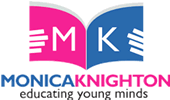When reading a fictional story, students must master the ability to understand the art of development. In other words, notice the author’s logical progression of ideas—from sentence to sentence; from paragraph to paragraph; and from chapter to chapter.
Because each chapter builds and exposes ideas intentionally, a critical reader seeks to identify the obvious while unveiling an author’s hidden messages. Here’s how: Students must not only summarize what is going on in the text, they must also recognize what the author is revealing in the details. Effective summarizing includes both. With the integration of this type of deeper analysis, an effective chapter summary will extend beyond the obvious. The Monica Knighton Way is a revolutionary approach to reading because the methodology facilitates the transition from basic comprehension to complex thinking. Here are a few tips to train readers on summarizing a section, chapter, or entire story.
Step 1: Identify the main points that are happening in the chapter. This is done when you purposely chunk the paragraphs. As you are reading, have an internal dialogue. Ask:
(a) What are the narration and dialogue mainly talking about? They are the obvious, right-there details to include in a summary.
Step 2: Analyze what the author is revealing through character interactions, narration, and dialogue. Also, give attention to how the story advances within and across each phase of the story’s plot structure. Notice recurring ideas or repetition of key words. Analyze shifts. In doing so, have an internal dialogue. Ask:
(b) What does the author really want me to know? These are the inferred details, and they should also be included in the summary.
Step 3: Synthesize steps 1 and 2 using a limited amount of words—as an example, write a 30-word summary of that chapter.
For more support, purchase The Adventures of Josh and Monkey series: Next Time I Will Obey! and Big Trouble, Josh!

